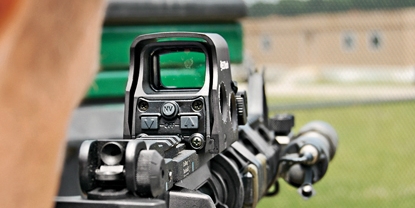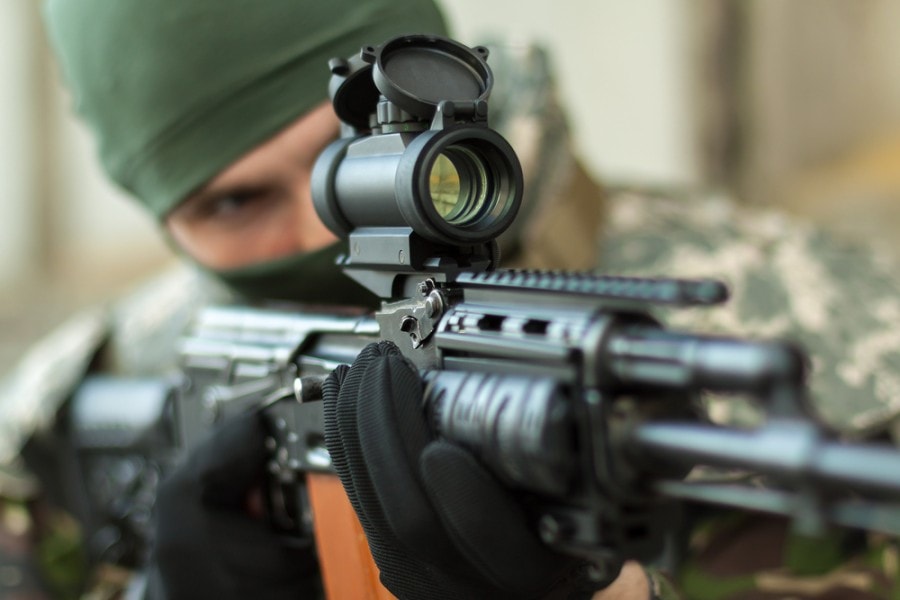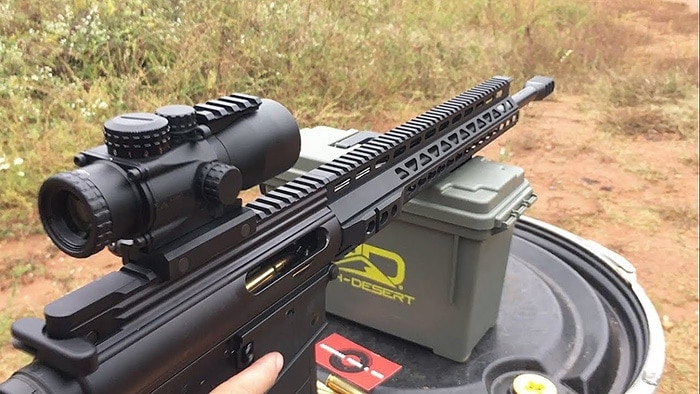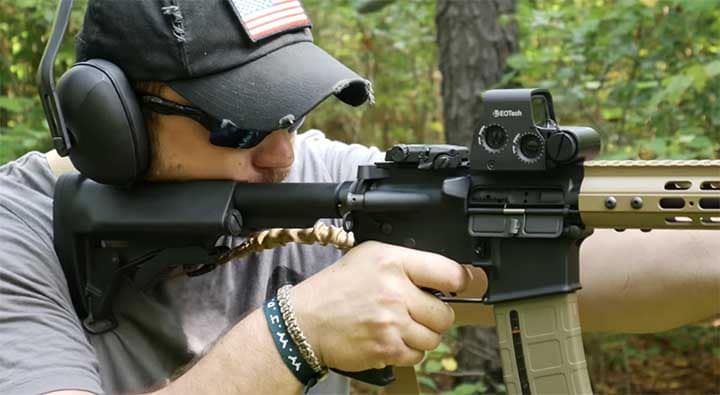Looking for a new sight for your rifle or sidearm and not sure where to start?
That's great because we'll go over what the different red dot sights are and for what they're best suited.
So grab a beverage and stay awhile; we're going to talk about some cool additions to your new toy or old comrade.

Photo credit: rifleopticsworld.com
Red Dot Sights vs Reflex Sights
Tube Reflex Red Dot Sights | Exposed Red Dot Sights |
|---|---|
Pros | Pros |
More Durable | Sleek look |
Better at preventing Fog | More open field of view |
Easier to Zero and Adjust | Smaller with a lower profile |
Cons | Cons |
Tube body might limit field of view | Parralax correction is weak |
Larger not good for concealed carry | Not as Durable in harsh conditions |
Best For | Best For |
Best for rifles and harsh combat environments | Great for sidearms and for concealed carry |
What is a Red Dot Sight, and How Does it Work?
Red dot sights are the umbrella under which all the other sight types fall. Simply put, a red dot sight is any sight that uses a manufactured image as an aiming reticle .
Whether the dot is red or purple is irrelevant, it still falls under the red dot category. Whether the dot is a dot or a crosshair is equally irrelevant because it also still falls under the red dot umbrella.
Many don't know that even prism sights, reflex sights, and holographic sights fall under the red dot category. However, that doesn't mean all red dots fit into all of those categories.

Photo credit: youtube.com
How it Works
A red dot has a light-emitting diode, or LED, which transmits a beam to the optic front glass, which has a coating type that reflects the beam to the eyes.
What is a Reflex Sight and How Does it Work?
Tube reflex sights are the ones most people think of when the term red dot sight is used. The tube reflex site looks like a traditional rifle scope.
However, there isn't any magnification happening inside this little body. Just a beam of light being launched from the rear lens to the front lens then reflected. The reflection back is what your eye translates as a dot, which is used as the aim point.
Then there's the exposed reflex site. The exposed reflect site doesn't have a tube body and only has a single lens. A light beam is projected onto the front lens, then sent back to the shooter's eye.
With the exposed reflex site, there isn't a body, so it makes target acquisition more efficient.

Photo credit: gadgets-reviews.com
How it Works
A reflex sight is one of the main types of red dot sight mentioned above. The reflex sight acquires its name because it uses a small LED light sent from the rear of the scope to the front lens, reflecting the light as a red dot which the shoot uses to aim.
Relevant Characteristics Between Red Dot Sights and Reflex Sights
Tube Reflex Red Dot Sights | Characteristics | Exposed Reflex Red Dot Sights |
|---|---|---|
Cell | Cell | Cell |
Good field of view because there isn’t an eye relief | Field of View | Great field of view because they only have a front lens |
Good because the dot is easily placed on the target with practically zero difficulty and keep both eyes open | Target Acquisition | Easier because having the single window allows the shooter to keep both eyes open and not have to look through a tube |
Equal depends on how the optic is set up in relation to the iron sights | Co-Witnessing Ease | Equal depends on how the optic is set up in relation to the iron sights |
Generally, a tube body will be a bit larger | Size | Single lens so normally smaller |
Doesn’t require protection from elements | Protection From Elements | Doesn’t require protection from elements but not as durable as a tube body |
Equal depends on the brand, some are available that don’t require batteries | Battery Life | Equal depends on the brand, some are available that don’t require batteries |
All red dots have a zero capability, and depending on brand and cost, Parallax and Windage Adjustments are offered | Zero/Parallax/Windage Adjustability | All red dots have a zero capability and depending on brand and cost, Parallax and Windage Adjustments are offered |
Similarities and Differences
Now, let's take a look at how these two types of optics compare to each other. Is one better than the other? What are some of the limitations? We will try to break these down into better fields so you can make a more informed decision. For this, we will be comparing red dot tube reflex sites and exposed reflex sites.
Reflex and Exposed Red Dot Sights Differences
While both the tube reflex sights and the exposed reflex sights both fall under the same umbrella, a person should consider some differences before making a final decision.
Reflex Sights
The tube reflex sight is better suited for rifles because, typically, rifles must endure harsher treatment than most sidearms. Most are air-tight and purged with nitrogen because of the space between the front and rear lenses.
Purging the center with nitrogen helps to ensure the aperture doesn't fog up. According to Murphy's Law, not fogging up is an essential characteristic because it'll only happen at the worst possible time.
Furthermore, zeroing a tube body reflex site is generally more straightforward as the adjustment knobs are typically larger and easier to manage. This is an important asset for those who might be getting a little older in the eyes.

Photo credit: huntingmark.com
Exposed Red Dot Sights
The exposed red dot reflex sites only have a front lens, giving an open window aim point. The exposed style sights allow the shooter to get the aim point into the field of view quicker, allowing faster response times.
However, because the sight doesn't have the sizable supporting body like a tube sight, it's more prone to sustain damage in harsher environments. The front lens is generally coated with an anti-fog solution that helps prevent fogging but isn't as effective as the nitrogen purged tube.
Zeroing adjustment knobs usually are small screws that will require a tool of some kind to adjust them. Not a huge drawback but can be limiting to those with poorer eyesight.
These aren't huge differences, but they're still different and worth considering before making a purchase.
Reflex Sights and Red Dot Sights Similarities
Of course, because the tube and exposed reflex sites fall under the same type of red dot sight, they have quite a few similarities. Both styles of reflex sights don't have eye reliefs allowing the shooter to engage their targets with both eyes open.
Engaging the enemy or other targets with both eyes open is crucial, especially while room clearing or engaging targets on the move. Having the non-dominant eye open allows it to watch for obstacles that might be blocking your path. Or, more importantly, see a target that pops out from behind cover or concealment.

Photo credit: hixmagazine.com
Both sights typically offer varying dot brightness as well. This comes in handy when conducting operations in various lighting environments. There are a couple of general rules when setting the brightness on your sight.
If engaging targets at a distance, say between 50-100 meters, turn the brightness up just enough to where you can see it well, but barely. Setting your brightness this way will keep the dot small, so you can better see the spot on the target you want your round to land.
Having only a front lens, the shooter can quickly bring the weapon up and, leaving both eyes open, engage their target with confidence. But, because of its exposed design, the shooter doesn't feel the need to use the sight-like scope and can quickly adapt from using an iron sight on a pistol to an exposed red dot reflex sight.
Zeroing
Most exposed red dot reflex sights have tiny screws located on the top and side of the aperture for adjustment. A small flathead screwdriver is generally required during adjustments. Because of this, zeroing with an exposed red dot reflex sight can take longer than with a tube.
Here's a little trick if you find yourself at the range without a flathead screwdriver for adjusting your sight. Find a spent piece of brass, or empty round casing, and smash the end of it with a rock or something hard till it's flat.
Voila, you have aIf conducting urban warfare training, such as room clearing or close-quarters combat, turn your brightness as high as possible without the dot distorting or hurting your eye.
Setting your brightness this way for this shooting style will speed up placing the dot center mass of your target. This will decrease the time between entering a room and squeezing the trigger.
Lastly, both these sights fall under reflex sights because of the way they work. The term "reflex" comes from the fact that the sights use a reflection of an LED to produce a sight aim point.
Originally they were referred to as reflection sights, but as time drew on, the name shortened to reflex sights. Unfortunately, this often confuses shoppers when they're looking for a sight for their weapon.

Photo credit: theguidr.com
Advantages of Reflex Sights
The red dot tube reflex sight is probably the most commonly thought of when a person thinks of a red dot sight. The red dot tube reflex sight is at the forefront of most people's minds because it's what's depicted on almost all soldiers' weapons.
Tube red dot sights look like your basic rifle scope. However, they're not magnified. With a larger rear lens and no eye relief, the shooter can easily pop the weapon up to their eye, acquire the target, and engage.
Having the large rear glass also allows the shooter to keep both eyes open, maintain good peripheral vision, keep one eye looking for the next target or other potential threats.
Zeroing
Usually, a tube red dot sight will have better adjustment knobs for zeroing. The reason they'll have better adjustment knobs is that they have larger bodies that support such knobs.
This feature is excellent for the older shooter whose fingers aren't as nimble or for the younger marksmen who don't want to hassle with tiny screws to adjust their sights.
Durability
Because the tube red dot sight has a large body, it's typically more resilient to bumps and bangs. This extra-durable construction is another reason it's so popular among the United States Army Infantry.
When kicking in a door to engage an enemy, the last thing a soldier wants to be concerned about is busting a lens on the optic.
The way the lenses are housed in a tube red dot sight gives them added protection from the surrounding environment. This protection is because the lenses are typically recessed in the tube at both ends, keeping them shielded.
Also, most tube reflex sights are better for varying weather conditions. Body reflex sights are better equipped for these situations because the area between the lenses is sealed air-tight and often purged with nitrogen to prevent the lenses from fogging.

Photo credit: opticsmag.com
Cliff-Note Version
It's a common practice that tube bodies are used for rifles, like an AR platform, because they will support the more extensive body more efficiently. Usually, this is because rifles have to endure more significant hardships than a pistol or secondary weapon.
Some find these better for longer shots because it still has the scope feel to it. It's allowing the shooter to block out the surroundings and focus on a target that might be around 200 meters.
If you know you're going to be putting your weapon through some tough times or might be faced with some longer shots, a tube body red dot reflex sight might be best.
Advantages of Red Dot Sights
The red dot exposed reflex sight has a different construction than the tube sight giving it a much different profile. The exposed reflect sight only has a front lens which projects the dot back to the user's eye.
Here are some other advantages.

Photo credit: tactical-life.com
Durability
The exposed red dot reflex sight is somewhat durable but not as durable as the tube reflex sight. The reason is that, well, the lens is exposed. Without a robust body to protect it, the lens is more prone to encountering flying debris or getting damaged while violently entering a room.
Some do offer an anti-fog coating, but again it doesn't typically do as well as the tube body's nitrogen purging. We talked to a former Sergeant from the U.S. Army Infantry, and he commented that he would have a hard time trusting an exposed reflex sight in the hands of his soldiers because of the harsh environments they often find themselves.
However, the exposed reflex sight has a much lower profile than the tube body, so it's most commonly used for sidearms, like 9mm or .45 calibers. The exposed reflex sight is perfect for these applications because the shooter can easily place the dot on the target compared to the iron sight.
Cliff-Note Version
The exposed red dot reflex sight is excellent for sidearms. That's not to say these sights are bad for rifles, though. Because the exposed reflex sight only has the front lens, it offers itself up to be used much like a pistol's iron sights are, concentrating primarily on the front sight post in a point and shoot firing style.
Also, its design in most cases is a shallow profile, making them, again, great for sidearms that might be carried in a concealed fashion.
If you're looking for a sight for your sidearm or a low profile sight for your target shooting rifle, the exposed red dot reflex site might be the better purchase.
What About Prism Sights?
Prism sights, or prismatic sights, are another form of red dot sight. Instead of reflecting light from a lens to the user's eye, it uses a prism to flip the image. Most prism sights have the reticle or aim point etched on the glass, illuminating in various ways.

Photo credit: robarguns.com
Because of how prism sights are designed, they can be more sophisticated and offer the shooter more information while peering through the sight. This ability comes at a cost, however.
In most prism sights, the rear sight is smaller, and the sight is typically magnified, making it difficult for quick target acquisition while in close quarters. Because of these attributes, prism, sights are most commonly used on rifles while engaging targets at longer distances.
Many soldiers prefer using prism-type red dot sights while in Afghanistan fighting mountaintop to mountaintop. In contrast, they like reflex red dot sights while deployed to Iraq, where the battles are conducted in an urban setting.
When thinking of a prismatic red dot sight, the best example is the ACOG. This type of sight has been made famous from being seen atop many soldiers' weapons and, of course, the video game "Call of Duty."
The prism red dot sights have a pretty substantial drawback when used in urban environments, though. Not only is it challenging to get your eye in the sight to drop the target at close range, where to aim on the target is different.
If your prism red dot sight is zeroed for 100 meters, when you enter a room to engage your target at center mass, you might find your rounds landing high. If you don't have a fabulous trigger squeeze, this could mean missing the mark high and right or left.
To compensate for this, you might find yourself having to aim more around the center of a target's stomach area to land your shots in the kill zone.
What About Holographic Sights?
Holographic red dot sights are the youngest addition to the red dot family. The holographic red dot sight works by recording light reflected from an object scene, decoding the information, and reconstructing the light field in the sights field.

Photo credit: ioutdoorpursuit.com
The holographic red dot sight is only produced by one company, EOTech. Because of this, it's costly.
With a rectangular optic window rather than a standard tube-style sight, it makes for a phenomenal field of view. It also allows the shooter to move their head around without changing the aim point.
The EOTech holographic red dot sight also allows for 3D and 2D use. It can be used like a front and rear sight post while protecting itself on the same target plane when looking through the window. Or be used in 2D for those close-quarters battle situations.
The EOTech holographic red dot sight is the most common sight used by Special Operation Teams in elite military groups. Its wide range of uses makes it best for the myriad of situations those soldiers are often in. However, Special Forces soldiers also have an unlimited spending account, so they get all the coolest toys.
For the average civilian, an EOTech probably isn't worth the cost of the device. Reflex sights are just as effective at a much, much, lower price tag. However, if you're a competition shooter or thinking of becoming one, then forking over your firstborn might be worth it to get first place.
Bottom Line
So we have established that a red dot sight is an umbrella that covers three types of sights.
- Reflex, or Reflective, Sights
- Prism, or Prismatic, Sights
- Holographic Sights

Photo credit: blackflagarms.com
We went through and discussed which each of them is and how they differ from each other. Also, we broke down the two types of reflex red dot sights so that when you're out shopping for that perfect sight for your weapon, you have a better understanding of what you're looking to purchase.
Remember, folks, red dot sights can, and most likely will, fail at some point, so having your iron sights set up in a manner where they can still be flipped up and used is an excellent idea.
That's all for now, always aim center mass, and it takes three shots to put a target down.
People Also Ask
We usually get some follow-up questions after a block of instruction. So, we took the most common questions and included them below. We hope we were able to catch your question.
Are Red Dot Sights Accurate?
Yes, red dot sights are just as accurate as iron sights so long as they're adequately zeroed. Always take as much time as needed to ensure your sight is properly zeroed to your weapon. If that takes 4 rounds or 40, keep at it till you're continually hitting center mass with a good grouping.
What Red Dot Sight Do the Navy Seals Use?
When an individual makes it into the Special Operations community, they have the privilege to choose whichever style sight they prefer. Most Operators, SEALS included, decide to go with the EOTech holographic sights because they offer a more comprehensive range of capabilities.

Photo credit: gunsweek.com
Is a Red Dot Good for Concealed Carry?
The exposed red dot reflex sight can be suitable for concealed carry. There are many on the market, so finding one that best fits your sidearm should be relatively straightforward. Tube red dot sights probably won't be as suitable for concealed carry because of their larger size.
Why are Reflex Sights so Expensive?
Reflex sights aren't expensive, and many can be found relatively cheap. It's the EOTech holographic sights that are seemingly outrageous. Holographic sights are so costly because EOTech owns the patent to their design and has a monopoly on their sale.
How Far is a Reflex Sight Good for?
Reflex red dot sights are acceptable up to any distance the shooter can adequately see the target. Soldiers in the U.S. Army Infantry regularly engage targets up to 300 meters with tube red dot sights as part of their quarterly shooting qualifications.
Some shooters have hit targets up to 500 meters, but this pushes the maximum aim point range of a 5.56 AR-style weapon


